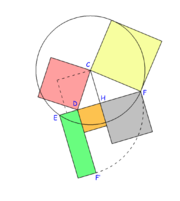Euclid



Euclid of Alexandria (Greek: Εὐκλείδης) (about 325 BC–265 BC) was a Greek mathematician who lived in Alexandria, Egypt and worked at the Library of Alexandria. Little is known about this person, but people think he lived there when Ptolemy I was Pharaoh. It is not known where and when he was born.
The Elements
[change | change source]Euclid collected together all that was known of geometry, which is part of mathematics. His Elements is the main source of ancient geometry. Textbooks based on Euclid have been used up to the present day. In the book, he starts out from a small set of axioms (that is, a group of things that everyone thinks are true). Euclid then shows the properties of geometric objects and of whole numbers, based on those axioms.
The Elements also includes works on perspective, conic sections, spherical geometry, and possibly quadric surfaces. Apart from geometry, the work also includes number theory. Euclid came up with the idea of greatest common divisors. They were in his Elements. The greatest common divisor of two numbers is the greatest number that can fit evenly in both of the two numbers.
The geometrical system described in the Elements was long known simply as geometry, and was considered to be the only geometry possible. Today that system is referred to as Euclidean geometry to distinguish it from other so-called non-Euclidean geometries which mathematicians developed in the 19th century.
Other works
[change | change source]In addition to the Elements, at least five works of Euclid have survived to the present day. They follow the same logical structure as Elements, with definitions and proved propositions.
- Data deals with the nature and implications of "given" information in geometrical problems; the subject matter is closely related to the first four books of the Elements.
- On Divisions of Figures, which survives only partially in Arabic translation, concerns the division of geometrical figures into two or more equal parts or into parts in given ratios. It is similar to a third century AD work by Heron of Alexandria.
- Catoptrics, which concerns the mathematical theory of mirrors, particularly the images formed in plane and spherical concave mirrors. The attribution to Euclid is doubtful. Its author may have been Theon of Alexandria.
- Phaenomena, a treatise on spherical astronomy, survives in Greek; it is quite similar to On the Moving Sphere by Autolycus of Pitane, who flourished around 310 BC.
Tributes to Euclid
[change | change source]
References
[change | change source]- ↑ Bill Casselman. "One of the oldest extant diagrams from Euclid". University of British Columbia. Retrieved 2008-09-26.
